Menu
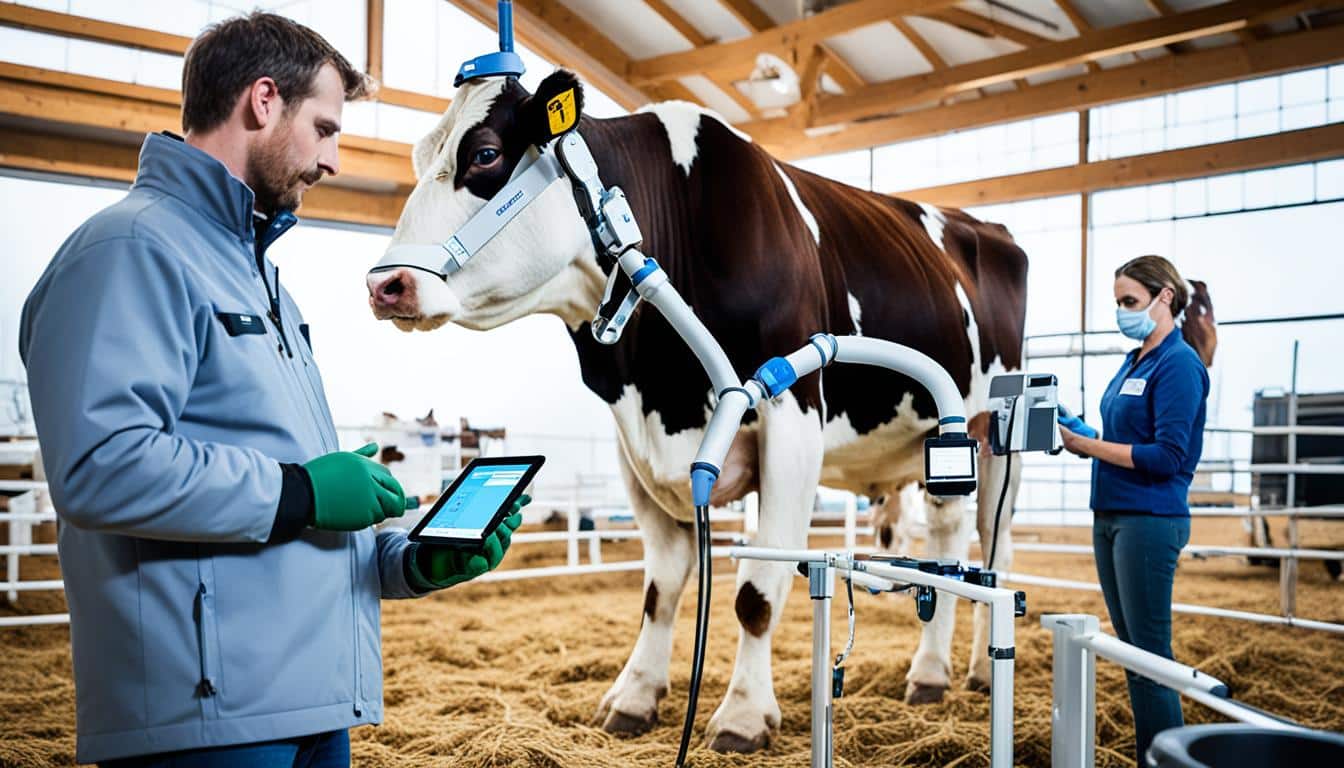
Did you know the global precision farming market will top £10.9 billion by 2026? This number shows how advanced livestock care is changing agriculture. Technologies like RFID tags and GPS tracking make herds smarter. They help with things like milking and tracking health, making farms more efficient and profitable.
Our way of caring for livestock is by using precision livestock farming (PLF). This lets farmers make choices based on data instead of guessing. With PLF, farmers can make herds healthier and more productive. Plus, they can find illnesses early and understand animal behaviour, which is good for the animals and the farm.
The world of livestock technology is changing farming. It’s making animal health and efficiency better than ever. Farmers use high-tech sensors, IoT tools, and data to watch over their animals closely.
New tech helps with challenges like disease and saving resources. It supports sustainable farming too. With advanced farming techniques, we can manage livestock better. This means healthier and more productive animals.
Introducing new solutions improves how we run farms. It also keeps animals healthier. These changes lead us towards smarter farming methods.
Adding technology to livestock care is changing things in a big way. It is making farming smarter and more efficient. With new tools, farmers can watch over their animals with more precision and knowledge.
Sensors are a key part of smart farming. They check things like body temperature and heart rate to spot illnesses early. This tech helps farmers find and fix problems before they get worse.
IoT helps by sending and analysing data in real-time. It links sensors to give instant updates on an animal’s health and its surroundings. This lets farmers act fast to keep their animals healthy, increasing productivity. The benefits of IoT in farming include:
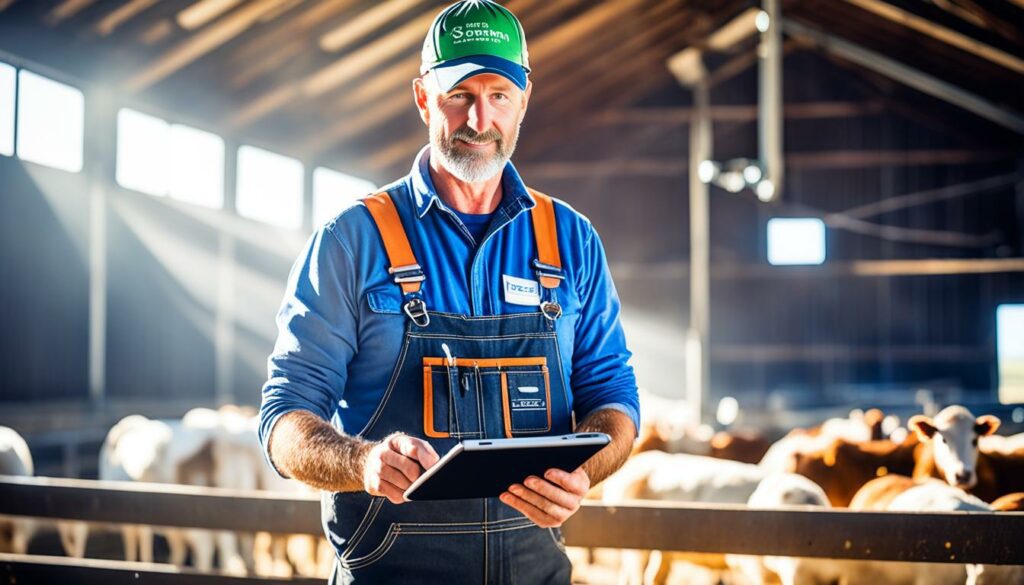
Automated technology takes over daily farm tasks. It lets farmers use their time better. Systems like automatic feeding and milking save time and make farms run better. By using sensors and automation, farms are more productive. This makes them more sustainable and profitable.
Here’s how traditional and automated farming systems compare:
| Aspect | Traditional Systems | Automated Systems |
|---|---|---|
| Feeding | Manual, time-consuming | Automated, efficient |
| Milking | Manual, labour-intensive | Automated, less labour |
| Health Monitoring | Visual and manual checks | Sensor-based, precise |
Precision Livestock Farming (PLF) is all about managing livestock accurately with the help of high-tech tools. It uses the latest tech to track and analyse data in real time. This way, farmers can watch over their cattle closely, making everything more precise.
The heart of PLF beats with the ability to collect a lot of livestock data using smart sensors and IoT gadgets. This data includes everything from health status to how they eat and move. With the power of analysis, farmers can deeply look into these details. They can then understand how well their livestock is doing and how to boost their farm’s productivity.
For example, smart sensors worn by animals can keep track of vital signs and how much they move. These are key in spotting illnesses early and checking their overall health.
PLF changes the game from guessing to making informed farming decisions. With instant data, farmers can choose the best actions quickly. This speeds up their farm work and makes everything work better. All these data also help in breeding, feeding, and keeping the animals healthy. This leads to more certain and well-taken-care-of herds.
This smarter way of doing things helps in running the farm more smoothly. That means using resources wisely and improving how the animals are looked after.
| Aspect | Traditional Farming | Precision Livestock Farming |
|---|---|---|
| Data Collection | Manual observation | Automated sensor-based |
| Decision-Making | Instinct-based | Data-driven insights |
| Resource Efficiency | Variable | Optimised resource use |
| Health Monitoring | Reactive approach | Proactive and predictive |
Technology plays a big part in keeping track of herd health. With advanced tools, we catch and deal with health problems early. This makes sure the herd is always in good shape.
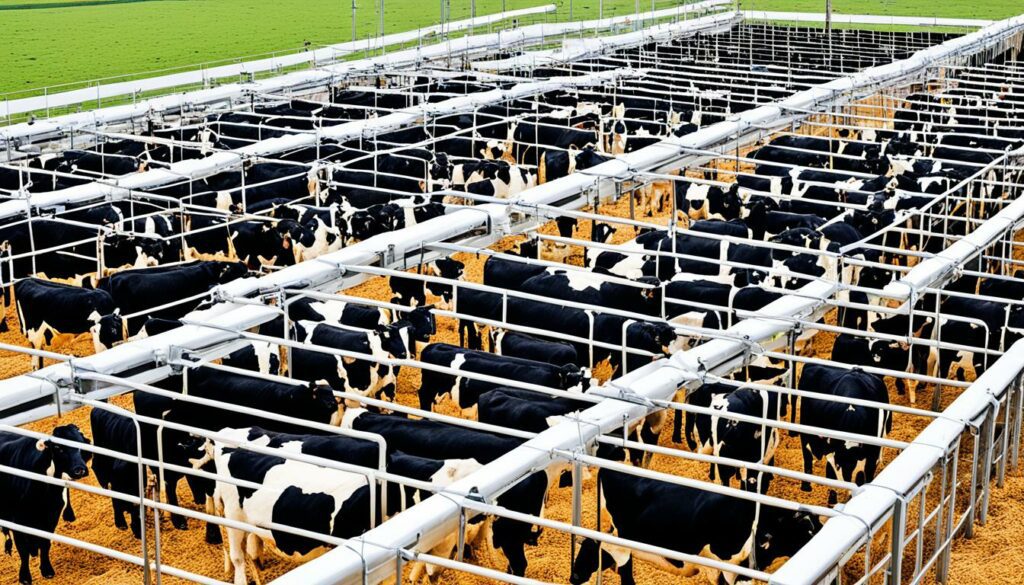
Spotting diseases early is key for looking after livestock. Things like wearable sensors and data analysis give us important health clues. This lets us act fast, keeping the herd safe and healthy.
Using analytics for monitoring helps us take action before things go wrong. By looking at past and current data, we’re able to foresee health risks. Doing this not only makes animal health technology more useful, it also lowers disease rates. This means more productive animals that live longer.
Getting to know how animals act is key in looking after them well. Today’s technology lets farmers dive deep into what, when, and how animals eat. This info is critical for making livestock healthier and more productive.
New tech allows us to watch an animal eat like never before. With RFID tags and sensors, we learn a lot about their meals. This close look can signal any health troubles early on.
By tracking an animal’s moves, we see how it gets along with others. This info is key to spotting times when they might be stressed. This stress could hurt how well they’re doing, but farmers can help by making the environment better.
Watching how animals eat and get along tells us a lot. It helps tailor care just for them. With good animal behaviour analysis, we can make them happier and more productive.
| Behavioural Aspect | Monitoring Tools | Benefits |
|---|---|---|
| Feeding Patterns | RFID tags, sensors | Early detection of health issues |
| Movement | Tracking devices | Understanding activity levels |
| Social Interaction | Observation tools | Enhanced livestock welfare |
Data-driven farming is changing the game in agriculture. It uses detailed insights to improve how we care for our animals. This change is driven by using analytics in livestock care and trend data in agriculture. It makes our herds healthier and more productive. It’s clear that using new technology has many benefits.
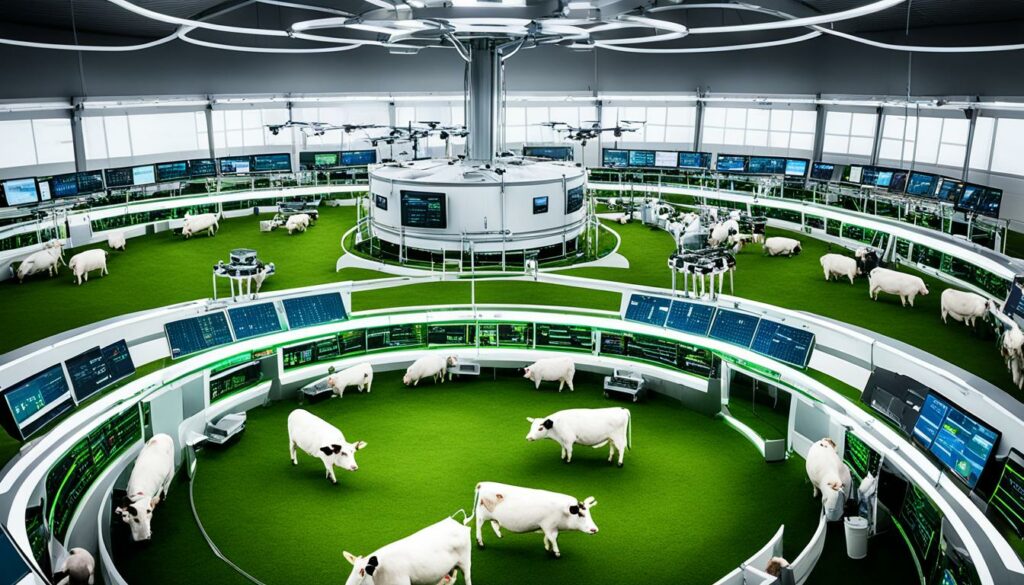
Trend analysis is key to understanding and improving animal health. It lets us see patterns in their well-being. Monitoring their health and performance closely helps prevent big problems. This keeps the animals in good shape. It ensures the farm runs smoothly and effectively.
Predictive analytics takes data-based farming to the next level. It looks ahead to predict health issues and other challenges. This allows for steps to be taken before problems arise. In this way, it saves both time and money.
“Adopting data-driven farming techniques facilitates informed decision-making, translating to a more productive and efficient agricultural practice.” – An industry expert’s perspective.
Using advanced tech in managing livestock is key to increase their productivity. These new tools help to better the feeding and breeding schedules. This, in turn, makes farming more sustainable and profitable.
The right feeding solutions are vital for top animal health and nutrition. Thanks to tech like auto feeders and precise nutrition systems, farmers can feed their animals perfectly. This means less waste, faster growth, and healthier animals.
| Feeding Method | Benefits |
|---|---|
| Automated Feed Dispensers | Precise feed allocation, reduced labour |
| Precision Nutrition Systems | Ensured nutrient balance, enhanced growth rates |
| Sensor-Based Monitoring | Real-time adjustments, improved feed efficiency |
Keeping track of breeding is very important for farm productivity. Today, we have tech like estrus detection and artificial insemination. They let farmers have better breeding control, leading to more successful pregnancies and a more productive herd.
| Breeding Technology | Advantages |
|---|---|
| Estrus Detection Systems | Accurate detection of heat periods, improved timing |
| Artificial Insemination | Enhanced genetic traits, better conception rates |
| Pregnancy Monitoring Devices | Real-time pregnancy tracking, early problem identification |
Integrating smart solutions into farming is crucial. It helps balance making money with taking care of the planet. Using advanced technology improves how we manage resources on farms. This helps protect nature and ensures we have a sustainable future for raising cattle.
Managing resources well is vital for sustainable farming. By using tools like precision feeding and water management, farmers can make the most of what they have. This cuts down on waste and saves money. It also helps protect the environment by reducing the negative impact of farming.
Keeping natural areas like pastures in good shape is key for sustainable farming. Techniques like smart grazing and rotational plans prevent pastures from being overused. They also help keep the soil healthy. This way, biodiversity increases, and the farm’s environment stays strong. It makes sure that sustainable farming is a wise and caring choice.
Using advanced technology in livestock care brings big benefits. But, there are hurdles to jump over before we get there. High costs and tech problems slow down farmers wanting to update their methods.
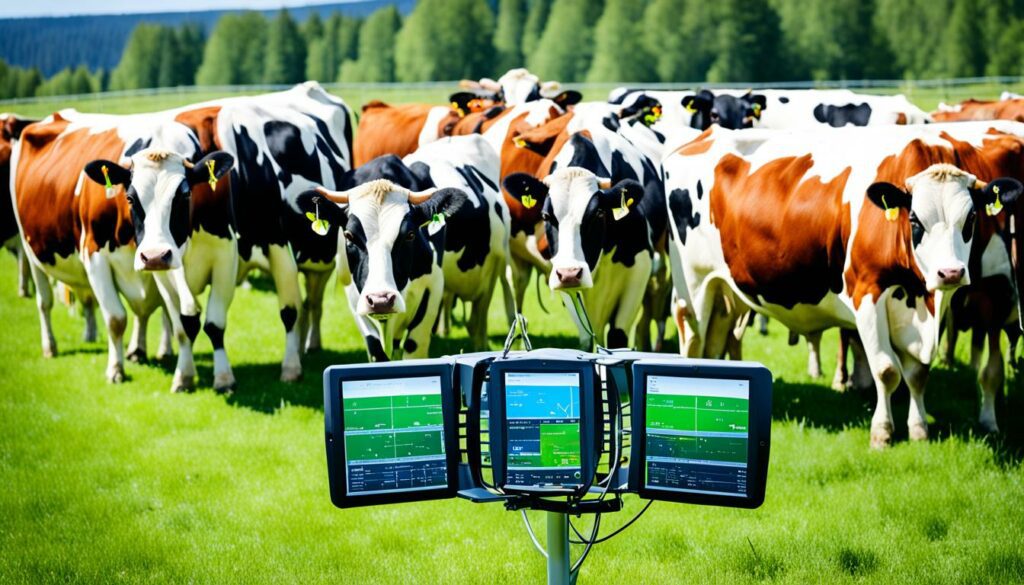
Investing in high-tech farming comes with a big price tag. New systems, like those for IoT and automation, can cost a lot. This especially affects small farms, stopping them from using helpful new tech.
Modern technology is usually strong, but it’s not perfect. Bugs, hardware problems, and connection issues can still happen. These can stop farm work and make farmers think twice about new tools.
Finding ways to tackle these problems is key for tech to grow in farming. New solutions aim to make tech cheaper and more reliable. We’re getting closer to a future with better farming that’s good for the planet and the pocket.
The future of farming is about to change with new tech. Machines and computer learning will give farmers new ways to manage their animals. This makes it easier to look after livestock and keep them healthy. At the same time, blockchain technology is upping the game in terms of safety and knowing where our food comes from.
AI is making a big difference in how we care for animals. It looks at lots of data to find trends and offer advice. This advice can help prevent problems before they even start, making farms run better. So, it’s not just about solving problems, but also keeping a close eye on the animals.
Using blockchain can make food supply chains safer and more honest. It records every step of food production, making sure everything is as it should be. This helps build trust with people who eat the food and makes keeping rules easier for farmers.
| Feature | Benefits |
|---|---|
| Immutability | Keeps data safe from changes, making it reliable. |
| Transparency | Gives clear views from start to finish, making people more confident about what they eat. |
| Traceability | Follows the whole life story of our food, meeting quality checks along the way. |
The idea of a ‘connected cow’ is changing how cattle are looked after. Farmers are using new technology to track cows through wearable sensors and real-time monitoring. This gives them key information on the health and well-being of each cow.

Modern farms now often use technology like animal wearables. These tools can track things like the cow’s vital signs, how they move, and their behaviour. The sensors are placed on the cow’s collar, ear tag, or even under the skin. This data helps farmers spot health problems early and take action fast.
Systems that monitor cows in real time help with herd management. They look at the data all the time to find any changes from normal. For example, they might notice if a cow isn’t eating as much or sleeping more. This helps farmers to act quickly and smartly to keep the cows happy and the farm running well.
Advanced technology is changing how we farm livestock. By looking at real cases, we can see the benefits. We learn how new tech improves old ways.
Modern tech is a big help on dairy farms. DeLaval’s robotic milking is a game-changer. It speeds up milking, increases the amount of milk, and keeps things smooth.
Farmers also use IoT. This gives them instant info on the cows’ health. It lets them act quickly to keep the cows in top shape.
| Farm Name | Technology Used | Benefits Achieved |
|---|---|---|
| DeLaval Dairy Farm | Robotic Milking Systems | Increased Milk Yield, Reduced Labour |
| Lely Farm Innovators | IoT Sensors | Real-time Health Monitoring, Early Disease Detection |
Ranches are also seeing the benefits of new tech. Things like wearable sensors and GPS tracking help manage herds better. Ranchers can watch how their cattle move and eat. This makes farming more efficient and the animals happier.
| Ranch Name | Technology Used | Benefits Achieved |
|---|---|---|
| Smith Ranch & Co. | Wearable Sensors | Improved Animal Welfare, Health Monitoring |
| Green Pastures Ranch | GPS Tracking | Enhanced Grazing Management, Efficient Pasture Use |
These stories show how tech helps on farms and ranches. They prove that successful livestock technologies make work easier and boost results. This isn’t just good for one farm. It could make farming better everywhere.
The livestock care sector is changing fast due to new tech. It’s crucial for today’s farmers to adopt these innovations. This helps make farming more effective.
Now, we can understand what animals need better, thanks to innovation in livestock care. Tools such as sensors, IoT, and data analysis are at the core of this change. They provide us with important information to improve how we run our farms.
Using technology-driven farming solutions is no longer a choice. It’s a key way to prepare for the future. These tools help farmers look after their animals better. They can check their health, follow their habits, and even spot health problems before they become serious.
Let’s take a look at how different techs have changed the farming world:
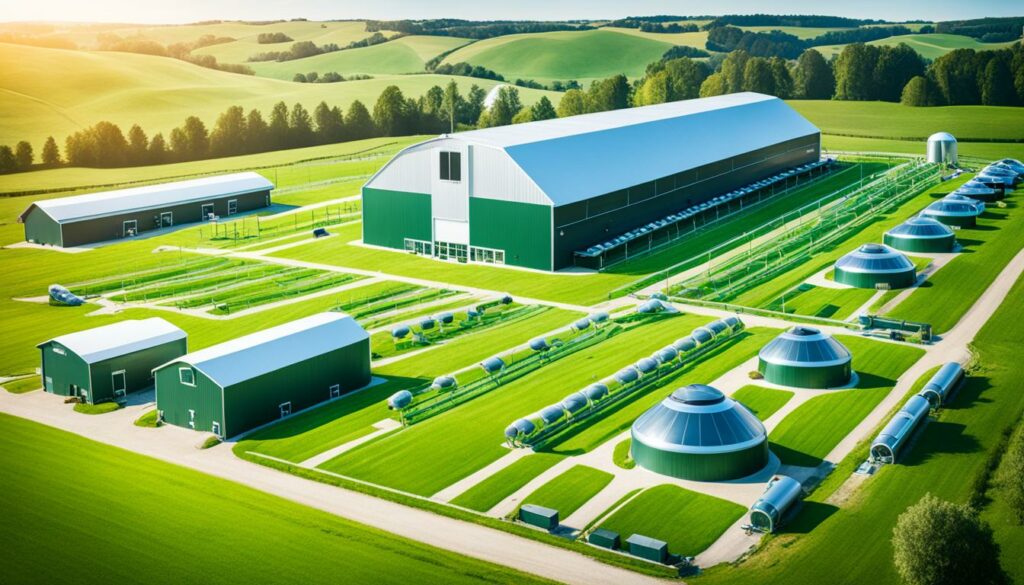
| Technology | Function | Benefits |
|---|---|---|
| Sensor-Based Monitoring | Tracks health parameters like temperature and heart rate | Enables early disease detection and timely intervention |
| Internet of Things (IoT) | Facilitates real-time data transmission and analysis | Empowers precise decision-making and resource management |
| Automated Systems | Streamlines routine tasks and operations | Enhances productivity and operational efficiency |
By bringing in technology-driven farming solutions, we’re changing how we care for livestock. This modernisation aims to make farming better in every way. We’re making sure our methods meet the needs of future farming.
The future of looking after livestock is closely tied to technology. Using advanced farm tech, we are improving how we take care of our animals. Methods like RFID tags, GPS tracking, and automated tools help enhance health and productivity.
It’s important to tackle the challenges technology brings early on. But the gains in the future far surpass the difficulties at the start. Ongoing tech developments help us make better, data-based choices for the welfare of our animals. This smart approach supports healthier livestock and more eco-friendly farming.
The livestock business is on the edge of big changes. It’s moving towards technology-driven, innovative methods for better farming. These steps lay the foundation for a flourishing, sustainable future in agriculture. And they bring benefit to both our animals and our farms.
Advanced livestock care technologies bring many advantages. They improve herd health and boost productivity. They also help farmers make better decisions and manage their farms overall.
Sensor-based tech watches over animal health. It tracks body temperature and heart rate. This helps spot diseases early and take action.
This tech also looks at an animal’s behaviour. This helps farmers know if their animals are stressed. It also helps make them more comfortable and productive.
The IoT links sensors to smartphones or computers. This connection lets farmers get crucial data in real time. It helps prevent health problems and manage the herd better.
Automated systems do many daily tasks, like feeding and milking. They cut down on physical work for farmers. This means they can manage their herds better and be more efficient.
Precision Livestock Farming means using tech to get instant data on animals. This data helps farmers make quick and accurate decisions. It improves health management and makes farms more profitable and efficient.
Early disease detection tracks animals’ health around the clock. It looks for sudden changes. If it finds any, it alerts farmers. This quick action helps stop illnesses spreading.
Predictive analytics forecast health risks. They suggest ways to prevent diseases. By looking at data, farmers can make their animals healthier and their farms more productive.
By tracking what animals eat, farmers get to know their needs better. This helps to feed them right. It ensures they get all the nutrition they need, preventing health problems.
Watching how animals move and interact shows a lot. It tells us about their stress, friendship, and behaviour. This helps farmers look after their animals better, improving their wellbeing and productivity.
Data helps farmers see what’s working and what needs attention. It lets them fix problems early. This approach makes farms run better and be more profitable.
Optimising feeding with tech ensures animals get the right food at the right time. This boosts their health and productivity. Animals grow better and are more efficient.
Advanced tech helps control when animals breed. This makes breeding more successful. It ensures baby animals are born healthy and the herd grows well.
Smart solutions include tech that uses resources better and manages water well. They help farms be more green and save money. It also protects nature.
Farmers can struggle with the cost of new tech and tech problems. But, the industry keeps working to make tech easier and more reliable for them,
AI and machine learning offer advanced ways to understand and predict from data. They help make better decisions. This improves how farms are run and how animals are cared for.
Blockchain makes tracking farm operations open and secure. It stores information like health and breeding safely. This helps manage farms and build trust with consumers.
A ‘connected cow’ wears sensors and is always monitored. This system gives crucial daily data for managing the herd well. It makes farm care quick, smart, and preventive.
Yes, dairy farms and ranches have done well with modern tech. They have seen big improvements in how their animals are cared for and how efficiently they run and work.